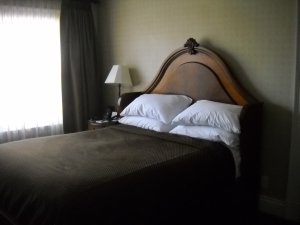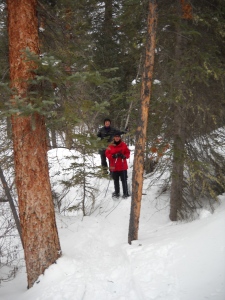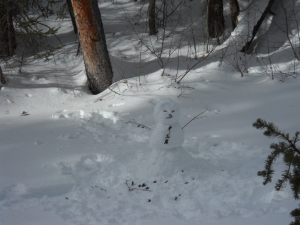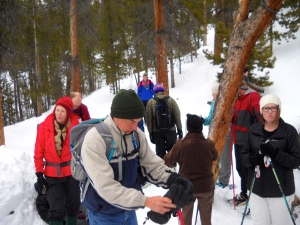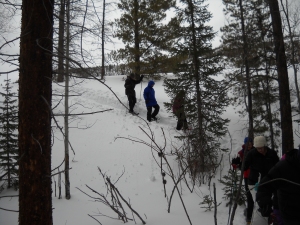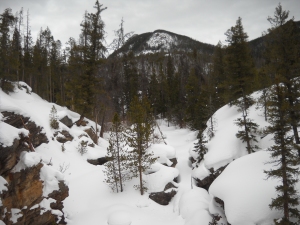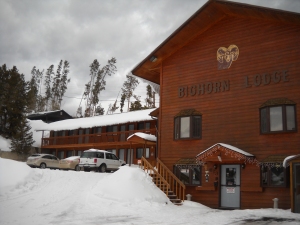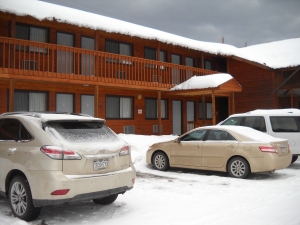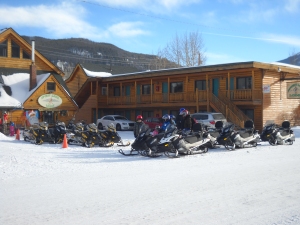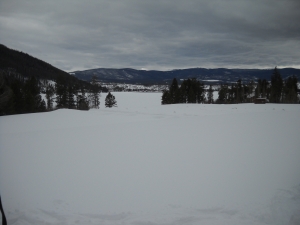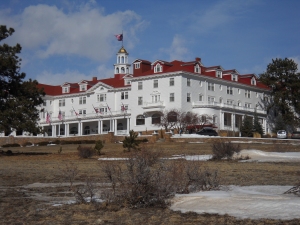 Upon check-in at the Stanley Hotel in Estes Park, Colorado, I discovered the Stanley offers various guided-tour opportunities. Two tours are available: an historic tour of
Upon check-in at the Stanley Hotel in Estes Park, Colorado, I discovered the Stanley offers various guided-tour opportunities. Two tours are available: an historic tour of 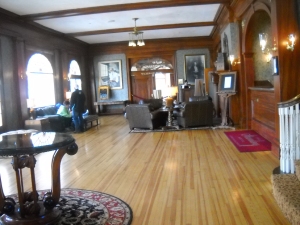 the grounds and hotel and a nightly ghost-hunting tour. I purchase a ticket ($15 February special, normally $20) for the two-hour historic tour. The tour begins with an introduction of our tour guide, Scary Mary, and a short video. We then traipse across the lawn to the concert hall where Scary Mary gives an informative and entertaining lecture about the history of the hotel. The Stanley was built in 1908 as a guest house for F.O. Stanley and his wife Flora. Stanley, an entrepreneur and inventor of the Stanley Steamer automobile, moved to the high altitude of the Rocky Mountains as a treatment for his tuberculosis. The Stanley’s loved to entertain and their celebrity guests loved to visit the hospitable Stanleys. Their guests included presidents, actors, and musicians. The musician on opening night of the concert hall was John Phillips Sousa performing on F.O.’s gift to Flora: a beautiful grand piano. In fact, Sousa was a frequent guest playing for the Stanley’s on numerous occasions.
the grounds and hotel and a nightly ghost-hunting tour. I purchase a ticket ($15 February special, normally $20) for the two-hour historic tour. The tour begins with an introduction of our tour guide, Scary Mary, and a short video. We then traipse across the lawn to the concert hall where Scary Mary gives an informative and entertaining lecture about the history of the hotel. The Stanley was built in 1908 as a guest house for F.O. Stanley and his wife Flora. Stanley, an entrepreneur and inventor of the Stanley Steamer automobile, moved to the high altitude of the Rocky Mountains as a treatment for his tuberculosis. The Stanley’s loved to entertain and their celebrity guests loved to visit the hospitable Stanleys. Their guests included presidents, actors, and musicians. The musician on opening night of the concert hall was John Phillips Sousa performing on F.O.’s gift to Flora: a beautiful grand piano. In fact, Sousa was a frequent guest playing for the Stanley’s on numerous occasions.
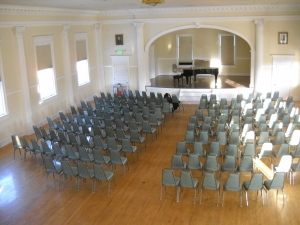 Our tour group returns to the main hotel, and we explore the ballroom which was the setting for Stephen King’s masquerade party in The Shining. I can envision the mafia-connected guests in their 1920s costumes and hear the party host as he shouts “Unmask! Unmask!” The only original piece of furniture in the entire hotel, Flora Stanley’s piano, the same piano that John Phillips Sousa played to entertain the Stanley’s guests, still sits in the piano room (which is currently a conference room). Scary Mary claims that sometimes mysterious music emits from the piano as a phantom Flora performs for guests and hotel employees. As we move into the lobby, guests and visitors to the hotel are lounging on the comfy leather sofas and chairs gathered around the two fireplaces in the hotel lobby, both with cozy fires blazing on this cold, February day. Scary Mary points out the Stanley Steamer automobile next to the doors of the hotel and explains F.O. Stanley’s invention, describing how it works and the purpose of the “mother-in-law” seat. In the event of an explosion, the rumble seat, the back seat, will be the part of the automobile that propels its passenger into the air, leaving the passenger behind as the automobile continues its way down the road. Thus Stanley reserved this special seat for his mother-in-law. We continue our tour, making our way towards the upper levels hallways, stopping on the staircase landing for a short history lesson of the previous ownerships of the Stanley Hotel. The Stanley has changed ownership several times in its history; but the current owner is the first to make a profit.
Our tour group returns to the main hotel, and we explore the ballroom which was the setting for Stephen King’s masquerade party in The Shining. I can envision the mafia-connected guests in their 1920s costumes and hear the party host as he shouts “Unmask! Unmask!” The only original piece of furniture in the entire hotel, Flora Stanley’s piano, the same piano that John Phillips Sousa played to entertain the Stanley’s guests, still sits in the piano room (which is currently a conference room). Scary Mary claims that sometimes mysterious music emits from the piano as a phantom Flora performs for guests and hotel employees. As we move into the lobby, guests and visitors to the hotel are lounging on the comfy leather sofas and chairs gathered around the two fireplaces in the hotel lobby, both with cozy fires blazing on this cold, February day. Scary Mary points out the Stanley Steamer automobile next to the doors of the hotel and explains F.O. Stanley’s invention, describing how it works and the purpose of the “mother-in-law” seat. In the event of an explosion, the rumble seat, the back seat, will be the part of the automobile that propels its passenger into the air, leaving the passenger behind as the automobile continues its way down the road. Thus Stanley reserved this special seat for his mother-in-law. We continue our tour, making our way towards the upper levels hallways, stopping on the staircase landing for a short history lesson of the previous ownerships of the Stanley Hotel. The Stanley has changed ownership several times in its history; but the current owner is the first to make a profit.
Scary Mary is an entertaining storyteller and we are all captivated as she relates ghost-sightings, events, and historic happenings throughout the entire hotel. The fourth floor was the original attic where the servants lived with their children. Supposedly, in the dark of the night, if you listen closely, you can still here the children playing in the hallway; and sometimes guests on the fourth floor are mysteriously “tucked in” as they settle in their beds for a night’s sleep. Now I know why the desk clerk asked if I like ghosts as he checked me into Room 414! The second half of the movie “Dumb and Dumber” with Jim Carey and Jeff Daniels was filmed at the Stanley and Scary Mary shares a few anecdotes. Jim Carey was assigned Room 217 (the room with the dead lady in the bathtub from The Shining) and after only three hours, he demanded to be moved to a different room. Carey never did say what happened during his short visit to Room 217; but other guests have reported “haunting” experiences during their stay in this very room. A ghostly apparition, dressed in old-fashioned chambermaid clothing, makes occasional, unexpected appearances.
We conclude the tour with a trip into the bowels of the hotel. The Stanley is built on a floating foundation around a granite mountain which is best seen by walking through a short tunnel that leads from the first floor hallway to the employee cafeteria. Scary Mary speculates that this granite foundation, at the core of the hotel, is the center where the Stanley Hotel receives its energy for ghostly happenings. Regardless of its “haunting” reputation, the Stanley Hotel is a fun, comfortable, wonderful place to stay when visiting Rocky Mountain National Park and nothing unusual occurred during my visit…this time……..


